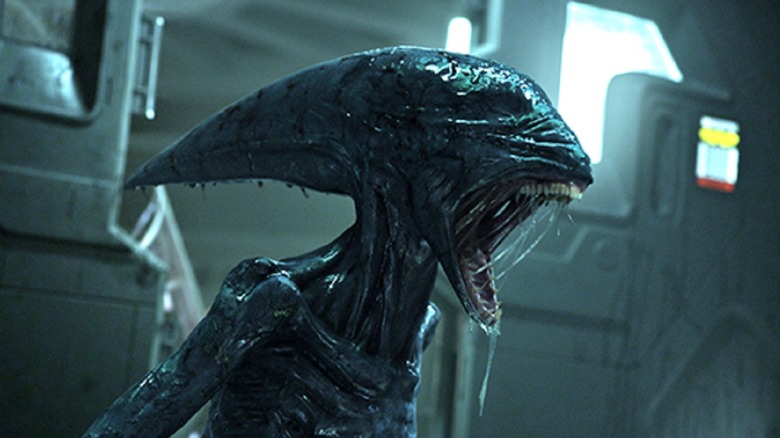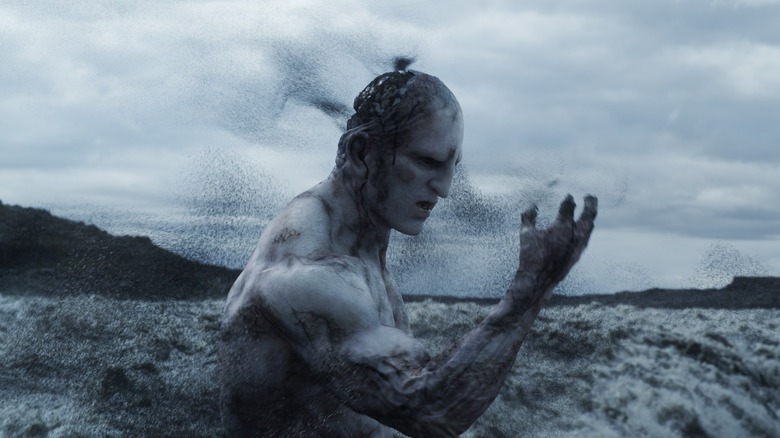The Xenomorph From Prometheus Had A Wild Fate Only Hardcore Alien Fans Know
Whether you love "Alien: Romulus" as a refreshing throwback to the original Ridley Scott classic that started it all or just couldn't get on board with its insistence on becoming a "Greatest Hits" collection, the release of the latest movie in the franchise earlier this month has had one undeniably positive effect — at least, for those fans of controversial, underappreciated, and utterly divisive movies like "Prometheus." The 2012 film has already been undergoing a critical reevaluation over the last few years, but its ever-growing ranks of defenders (come on in, folks, the water's warm and there's still time to join the right side of history) certainly won't mind an added boost to its reputation these days. And as if to prove the truth of the android villain David's words that "Big things have small beginnings," the prequel is still throwing new and thoroughly unexpected reveals at us to this day, over a decade after its initial release.
As is usually the case with the internet's most fascinating rabbit holes, this latest bit of "Prometheus" lore comes courtesy of an innocuous Twitter post (rumor has it that rebranding the social media site into "X" was one of the reasons why the Engineers wanted to destroy humanity). Many have idly speculated as to the whereabouts of the one and only Xenomorph that actually appears in the film, the creepy-looking "Deacon" that pops up during the very last scene as a result of the unholy union between an Engineer and the monstrous "Trilobite." Well, wonder no more. In a fitting twist for a story that's all about delivering the most unsatisfying answers possible to our most burning questions, it turns out that there's actually a canonical explanation for what happens to that Deacon.
And the Xenomorph's fate is absolutely wild.
Making mountains out of Xeno-molehills
Considering how many weird twist and turns this franchise has taken over the last few decades, well, what's one more oddity added to the mix? This particular one explains what that little Deacon gremlin got up to while stranded all those years on planet LV-223 after it was born, long after the main character in "Prometheus," Elizabeth Shaw (Noomi Rapace), and her homicidal android sidekick David (Michael Fassbender) took to the stars and bombed the ever-loving crap out of the Engineer home planet with that nasty black goo (which, of course, came back in a big way in "Alien: Romulus"). I don't really know how else to put this after so much buildup, so I'll just spell it out. Apparently, the Xenomorph turns into ... a mountain?!
This is according to an official tie-in comic book titled "Aliens: Fire and Stone," which picks up over 100 years after the events of "Prometheus" and follows a new cast of characters who end up on that same godforsaken moon. Late in the story, the crew ends up exploring the insides of a mountain near where the Prometheus ship ultimately crash landed. It doesn't take long before they begin to realize that the surrounding rock actually appears to be "alive" and that their efforts to tunnel through seems to have the same effect as injuring a facehugger or Xenomorph — in effect, lots of acid.
The extremely unsubtle implication here is that the Deacon returned to the wreckage of the Prometheus, mutated as a result of the bizarre circumstances of its birth, and literally turned into a living, breathing mountain for the rest of its existence. No, I swear I'm not making this up.
The Deacon's fate actually fits the Alien franchise
"Prometheus" notoriously underwent several major changes on the way from script to screen, so it's practically tradition to throw in another little wrinkle that completely rewrites the movie's ending. Remember, this is a series that took the biggest mystery at its center — What the heck was that space jockey and where did those Xenomorphs come from in the first place? — and turned this origin story into a rich, thematic exploration of faith, the horrifying nature of creation, and all our deepest and most existential fears. Oh, yeah, and the plot was originally meant to drop some unsubtle hints about Engineer Jesus in the midst of all that zaniness. (Seriously, people, I'm telling you, it's long past time to pick up what both "Prometheus" and its sequel, "Alien: Covenant," were putting down.)
Although this addition to "Alien" lore isn't one that came out of the wonderfully ridiculous mind of Sir Ridley Scott ("Aliens: Fire and Stone" was written by Christopher Sebela and illustrated by Ariel Olivetti), the explanation genuinely isn't all that far-fetched compared to anything that's come before or after in this series. Forget the (somewhat tenuous) crossovers with the "Predator" franchise over the years — taken entirely on its own merits, the "Alien" movies and expanded-universe material have always taken bold swings and introduced out-of-left-field turns when we least expect it. Granted, in terms of the Xenomorph lifecycle, a mountain doesn't exactly fit into our understanding of the evolution for these "perfect" organisms. But it doesn't exactly contradict anything, either. Go wild, man!
In comparison to all this, that gnarly final act of "Alien: Romulus" almost feels downright unremarkable. If/when we ever find out more inexplicable secrets in "Alien" canon, let's hope it's as gonzo as this.
"Alien: Romulus" is currently playing in theaters.


